Tech tip 25 Loading Ramp Technique
| Tech tip 25 Loading Ramp Technique |
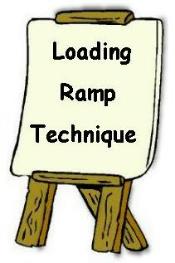 |
The following procedures are for reference use only and are in no way an endorsement for violating the ramp manufacturers Cautions & Warnings
WARNING
Danger of serious personal injury exists. Serious personal injury can occur when using a loading ramp.
· Never ride an ATV up a loading ramp.
· Always attach safety chains if provided.
· Make sure the safety chains are properly adjusted for length to prevent kick back of the loading ramp.
RAMP CONSTRUCTION
Metal loading ramps generally can be found in two materials, steel and aluminum. Most styles are either bi-fold or tri-fold. We have found the aluminum tri-folds are the easiest to handle. All commercial loading ramps are load rated. Choose a ramp with a load rating of at least 1000lbs.If you have a heavy-weight 4×4 and ride the ATV up the ramp and you don’t happen to be a 5ft.2in. SYT (sweet young thing) then consider a 1500 lb. load rating.
There are two basic construction types for these ramps, diamond mesh and rungs. If you plan on loading something like a riding lawnmower besides your ATV, then go with mesh. The smaller lawnmower tires fall into the space between the rungs and create a bumpy load and unload. However the rung-style loading ramp provides greater traction to an ATV tire if the ramp angle is steep or the conditions are wet.
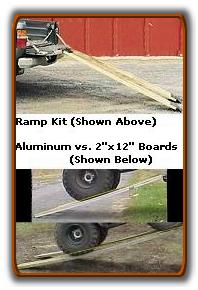 You can also build a ramp with a ramp kit consisting of a metal end that accepts a 2×8 or 2×12 wood plank. If you go this route werecommend NOT using a 2×8 for any ATV/rider combo that would gross over 600lbs. Why? Because 2×8’s just don’t have the strength to carry an ATV AND a rider safely during loading. Note how the 2×12 board is deflecting under the weight of the Prairie and rider (830 lbs!) If you get this much deflection with a 2×12, imagine how much you would get with just a 2×8! Also note how little the aluminum ramp deflects. One final note: When lumber deflects it can suddenly break! An aluminum or steel ramp will bend. We would also recommend the purchasing of a traction kit for the wood. When wet or snowy, plain lumber provides little traction, especially at a steep load angle. Plus, the chances of slipping off the side of a wet slippery plank are greatly reduced if your tires start to spin.
You can also build a ramp with a ramp kit consisting of a metal end that accepts a 2×8 or 2×12 wood plank. If you go this route werecommend NOT using a 2×8 for any ATV/rider combo that would gross over 600lbs. Why? Because 2×8’s just don’t have the strength to carry an ATV AND a rider safely during loading. Note how the 2×12 board is deflecting under the weight of the Prairie and rider (830 lbs!) If you get this much deflection with a 2×12, imagine how much you would get with just a 2×8! Also note how little the aluminum ramp deflects. One final note: When lumber deflects it can suddenly break! An aluminum or steel ramp will bend. We would also recommend the purchasing of a traction kit for the wood. When wet or snowy, plain lumber provides little traction, especially at a steep load angle. Plus, the chances of slipping off the side of a wet slippery plank are greatly reduced if your tires start to spin. Danger of serious personal injury exists. Serious personal injury can occur when using individual loading ramps.
· Aligning individual ramps to correctly correspond to your ATV’s track.
· Loosing traction and spinning sideways will result in the ATV slipping sideways off the ramp, tipping sideways and possibly falling on the rider causing injury.
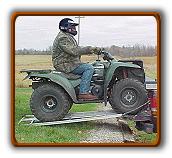 There are three loading conditions where you would use a loading ramp. 1.Loading from a wall or knoll with little ramp angle as shown at left. 2. Loading with the truck in a depression to reduce ramp angle and 3. Loading from level ground with the ramp angle at its steepest. If possible always try to look for a wall or depression (like a ditch) to reduce the loading ramp angle, because the shallower the ramp angle, the easier the loading of the ATV will be.
There are three loading conditions where you would use a loading ramp. 1.Loading from a wall or knoll with little ramp angle as shown at left. 2. Loading with the truck in a depression to reduce ramp angle and 3. Loading from level ground with the ramp angle at its steepest. If possible always try to look for a wall or depression (like a ditch) to reduce the loading ramp angle, because the shallower the ramp angle, the easier the loading of the ATV will be. 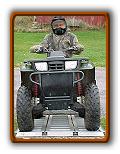 suggest practicing by placing the ramp against a low wall and making a few passes to get the “feel” for how the ramp reacts to the load of an ATV and you. Adjust your line until you can reliably hit the center of the ramp consistently. If you are off to one side and the ground is uneven where the ramp touches the ground, an unbalanced situation can occur.
suggest practicing by placing the ramp against a low wall and making a few passes to get the “feel” for how the ramp reacts to the load of an ATV and you. Adjust your line until you can reliably hit the center of the ramp consistently. If you are off to one side and the ground is uneven where the ramp touches the ground, an unbalanced situation can occur.
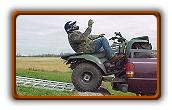 Danger of serious personal injury exists. Serious personal injury can occur when using loading ramps without safety chains. When an ATV’s front tires are on the truck bed and the rear tires spin, an unsecured loading ramp can be spun out from under the ATV causing the ATV to flip over backwards onto the rider.
Danger of serious personal injury exists. Serious personal injury can occur when using loading ramps without safety chains. When an ATV’s front tires are on the truck bed and the rear tires spin, an unsecured loading ramp can be spun out from under the ATV causing the ATV to flip over backwards onto the rider.· Never use a loading ramp without safety chains.
· Always attach loading ramps safety chains to the trucks tailgate retainers.
· Ensure safety chain length does not allow rearward movement of the loading ramp
How many of you have ever bothered to adjust the loading ramp’s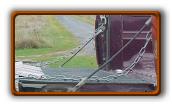 safety chains (if you even bother to use them at all!)? Place the loading ramp on the edge of the tailgate and attach the safety chains to the latches of the tailgate. Now pull the loading ramp rearward. If the majority of the flat lip of the loading ramp is pulled off the edge of the tailgate or it can be pulled completely off the tailgate, the chains need to be adjusted. As shown in the photo at right, the further safety chain has been shortened 4 links over the nearer chain.
safety chains (if you even bother to use them at all!)? Place the loading ramp on the edge of the tailgate and attach the safety chains to the latches of the tailgate. Now pull the loading ramp rearward. If the majority of the flat lip of the loading ramp is pulled off the edge of the tailgate or it can be pulled completely off the tailgate, the chains need to be adjusted. As shown in the photo at right, the further safety chain has been shortened 4 links over the nearer chain.
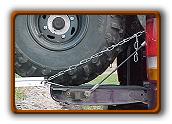 Use a pair of pliers to hold the chain and a flat-blade screwdriver to spread the “S” hook located at the end of the chain. Remove the link and shorten the chain so the loading ramp can not be pulled backwards by the ATV’s rear tire more than an inch or two as shown in the photo at left.
Use a pair of pliers to hold the chain and a flat-blade screwdriver to spread the “S” hook located at the end of the chain. Remove the link and shorten the chain so the loading ramp can not be pulled backwards by the ATV’s rear tire more than an inch or two as shown in the photo at left.
With your safety chains properly adjusted for length, try to locate either a mound or wall to raise the bottom of the loading ramp or a ditch to back the truck into to lower the bed height. Either of these will reduce the loading ramps incline angle. It is always best to load with the least ramp angle but this is not always possible. I suggest you practice loading from a wall, loading from a ditch and loading without the aid of any angle reduction whatsoever.
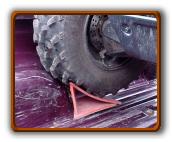 loading ramp at a slow speed because, with both front and back wheels driving, traction is not a problem. It helps to have a small ramp to assist one front wheel get over the rear wheel well in a mid-size or smaller truck. This is because on the smaller trucks, the distance between the rear wheel wells is less than the width of a full size ATV and you must ride up and over one wheel well to get in the truck far enough to close the tailgate on a 7ft. box. With a 6ft. box the ATV’s rear tires will remain on the tailgate.
loading ramp at a slow speed because, with both front and back wheels driving, traction is not a problem. It helps to have a small ramp to assist one front wheel get over the rear wheel well in a mid-size or smaller truck. This is because on the smaller trucks, the distance between the rear wheel wells is less than the width of a full size ATV and you must ride up and over one wheel well to get in the truck far enough to close the tailgate on a 7ft. box. With a 6ft. box the ATV’s rear tires will remain on the tailgate.
With a 2×4 machine, especially at steeper ramp angles, speed (momentum) is more important than traction, especially if you have to ride up and over a wheel well. It will take practice to ride a 2×4 ATV up a steep angled loading ramp at +10mph and hop over a wheel well and come to a stop before hitting the rear of the bed. (See warning below) It is best to cut throttle as you start up the wheel well (or the helper ramp) and apply the front brakes as you reach the top and then slide down on the other side of the wheel well into position.
WARNING
Danger of serious personal injury exists. Serious personal injury can occur when loading a 2×4 ATV as described above. The above procedure is for expert riders only.
One final note after loading; remember to turn the key off and remove it, turn the fuel off and set the parking brake. For manual clutch machines, leave the machine in gear. Fold up your ramp and slide it under the ATV securing it from sliding out if you have to leave the tailgate down.
